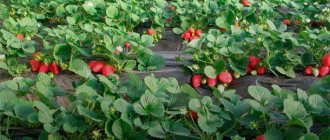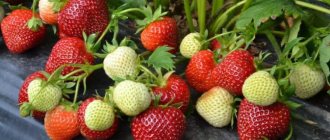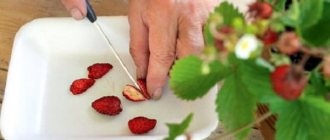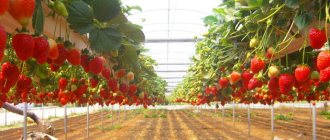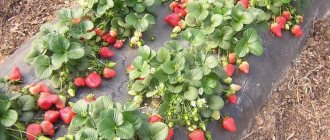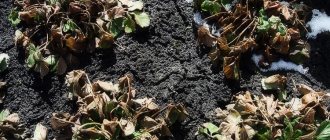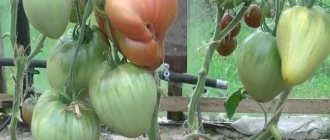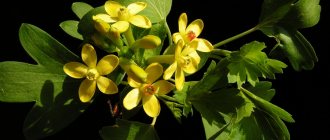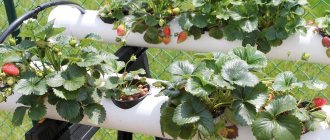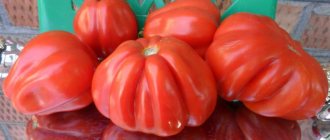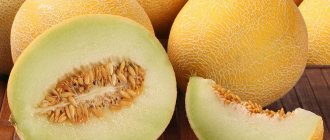Ampelous strawberries are a climbing variety of crop that can grow not only in the garden or garden, but also at home. The name “ampel” comes from the German word “hanging vase” - this means that the plant was once used exclusively for decorative purposes, that is, planted in flowerpots and hung from the ceiling as decorative items. Modern gardeners and gardeners appreciate the benefits of the berry and actively cultivate it in different places and conditions. What are the features of ampelous strawberries, care and cultivation of berries, what you should know about in order to get a lot of tasty fruits.
Ampel strawberry
What is ampelous strawberry
It should be noted that in the literal sense of the word, such strawberries are not cascading . Usually, a remontant variety is selected for planting with the ability to produce a large number of tendrils and fruit rosettes, which can, without coming into contact with the soil, produce new tendrils with peduncles.
Usually the mother bush itself is small, but the length of the mustache will impress even an experienced gardener with its size, because it can reach a meter in size.
Interesting! Although most varieties have white petals, breeders have developed varieties with pink petals. For example, pink flamingo, Tristan and others.
Fruiting
A curious moment is the fruiting of ampelous varieties of strawberries.
Since the bush produces mustaches before the flower stalks are formed, already ripening berries may well be hanging on the mother plant , and only bud ovaries on the daughter rosettes. This feature gives the plant additional decorative features.
The shape of the berries (conical, round or elongated oval) and shades of taste are dictated by varietal characteristics.
So, the fruits may have notes:
- citrus;
- pineapple;
- nutmeg;
- strawberries
The weight of the berries usually ranges from 15 to 30 g, they are characterized by rapid ripening, and the bush itself has a long period of fruiting.
Repairability
Remontant varieties are grown as .
It is this feature that allows you to harvest more than one harvest during the season and enjoy the sight of a bush, at the same time strewn with flowers and berries.
Self-fertility
Self-fertility is the ability of a plant to pollinate itself without the participation of pollinating varieties planted nearby.
Most varieties of ampelous strawberries are self-fertile.
Sustainability
Ampelous varieties are characterized by moderate frost resistance , but at the same time they have a low coefficient of drought resistance.
Due to the fact that ampelous varieties are mostly hybrids, they are highly resistant to diseases traditional for strawberries and successfully resist invasions of insect pests.
Taste and Application
The taste of fruits is determined by varietal characteristics and may have characteristic nuances.
But it should be noted that all the berries are large, regular in shape and have a slight sourness in addition to the rich strawberry taste.
Are climbing garden strawberries a myth?
It takes your breath away when you see in bright photos magnificent cascades of green shoots strewn with red berries. The summer resident's heart beats faster. I immediately want to buy seedlings and plant this “miracle” in my garden. What a disappointment it is when you find out that the climbing strawberry is a myth and this species does not exist in nature.
But what about the photographs, is it really photoshop and successful editing? So, in the Rosaceae family, of which the garden strawberry (strawberry, Victoria) is a representative, there are no vines, so calling some types of crops climbing is incorrect from a biological point of view.
But ampelous varieties have been bred, distinguished by the presence of long mustaches with fruiting rosettes. Unlike ordinary species, these plants produce berries both on peduncles and on tendrils (without contact of the latter with the soil).
Planted in hanging baskets, flowerpots, or on any elevation, the bushes produce garlands of mustaches. It seems that the plant is climbing, although the long shoots simply hang down.
It is these hanging varieties that delight gardeners, and inexperienced summer residents consider them a climbing crop. But if you are not picky in the use of terms, then in part such strawberries fit the description of varieties of climbing plants, and even those who are just getting acquainted with the basics of gardening can grow them.
Advantages and disadvantages
Among the advantages of hanging varieties, gardeners note the following features:
- the plant is able to fully develop and bear fruit even with a lack of sunlight, which makes it possible to place the bush in places that are not the most favorable for other varieties;
- long fruiting period;
- excellent taste;
- high yields;
- Possibility to place in vertical flower beds.
But ampel strawberries also have a number of disadvantages:
- The plant needs regular replanting. Every 3 years you need to find a new place for her.
- This feature leads to another drawback - high requirements for soil quality. Simply applying fertilizer is not enough. By the end of the 3rd year, the berries become noticeably smaller and the bush needs to be replanted.
- Picky about soil moisture.
Growing from seeds
The germination and further development of the plant depends on the choice of seeds. All manufacturers indicate the shelf life of seeds is 5 years, but after 2–2.5 years they begin to lose their quality characteristics, and the germination of such material decreases. You should choose earlier packaging dates.
Seed germination begins with soil preparation. The recipe for preparing the mixture can be taken the same as for ready-made seedlings. But in a city apartment it can be difficult to independently prepare fertile soil for seedlings; here a soil mixture enriched with microelements and nutrients, which is sold in the store, comes to the rescue.
The technology for seed germination is the same for almost all climbing varieties of berries:
- sowing dry or sprouted seeds;
- covering containers with glass or polyethylene;
- moistening the soil by spraying.
But varieties such as “Baron Solemacher” and “Alexandrina” have some nuances.
- “Alexandrina” seeds are soaked in warm water for 20–25 minutes, then distributed on the surface of the prepared soil and placed in the refrigerator for 2–3 days. After the stratification stage, which is necessary to improve the quality of the seedlings, the seed pots should be covered with glass.
- “Baron Solemacher” involves soaking the seeds for a couple of minutes before sowing in a special “Gumat” solution, which promotes rapid germination. The dried seeds are placed on the surface of thoroughly moistened soil and covered with glass.
Next, the germination process follows the following scheme:
- it is necessary to promptly remove condensation accumulated on the glass;
- ventilate the emerging sprouts;
- maintain optimal soil and air humidity;
- Pick up the sprouts after 3 leaves appear.
Planting of stronger bushes in a permanent place is carried out after 70–80 days. Further care for all varieties becomes the same.
The best varieties of ampelous strawberries
Among the variety of varieties, gardeners distinguish the following varieties.
| Varieties | Description |
| Rikla | This is a non-remontant variety, zoned for the North Caucasus. Rikla fruits are round, light green at first and bright red when ripe. Early ripening variety. |
| Elsanta | The variety belongs to the mid-season, is distinguished by its compact size and the presence of light fluff on the leaf blades, as well as the high ribbing of the leaves themselves. The fruits are large, up to 50 g, with a light sweet and sour taste. |
| Tarpan | The bush has pink flowers. Medium-sized berries weighing up to 35 g with a pronounced strawberry flavor and aroma. |
| Victoria ampelous | The variety, beloved by many gardeners, is characterized by high frost resistance and high disease resistance. The fruits are quite large, very tasty, but have a short shelf life. |
| Temptation | High-yielding variety, zoned for the middle zone. Suitable for growing in pots and flowerpots, which is why it is often grown on balconies. The berries are large, with a bright nutmeg aroma. |
| Delis | The variety was released in 2016. High-yielding, it is possible to remove about 1.5 kg of fruit from one bush. The berries are round and have a bright aroma. |
| Laurent | An early ripening variety with large berries of a rich red hue. |
| Tuscany | A young variety with high yields. The berries are conical, very juicy and aromatic. A notable feature of the plant is the compact size of the bush, about 30 cm, and very long mustaches, reaching a meter in length. |
| Kletter star | With a small bush size, it forms quite a lot of mustaches. Strawberry fruits are large (up to 60 g), juicy and aromatic. The variety demonstrates high frost resistance. |
| Fresco | It is distinguished by its small fruit size - only about 20 g, but at the same time the fruiting period is very long (from June to the first frost). |
| Queen Elizabeth 2 | A remontant variety that produces 2–3 harvests per season. The berries are large (up to 50 g), juicy and very aromatic. |
| Alba | The first fruits can be harvested as early as May. The main feature of the variety is the high transportability of the fruit. The berries are large (up to 50 g), juicy and very aromatic. It is possible to remove up to 1.2 kg from one bush. |
| Homemade delicacy | The variety is valued for its high decorative qualities; at the same time, fragrant, juicy fruits are harvested from it almost all summer. |
Growing from ready seedlings
For seedlings purchased in a store, you need to remove all the greenery, then plant the roots in the prepared pot. It must match the size of the bush. On average, the volume of the container should be at least 2 liters and the height 13–15 cm. All containers in which the seedlings will be planted must have good drainage (pebbles or expanded clay) to remove excess moisture, as well as drainage holes.
After the basic preparations, add nutritious soil - you can buy it and prepare it yourself. To do this you need to take in equal parts:
- turf;
- humus;
- sand.
Mix all the ingredients until smooth and pour in a weak solution of potassium permanganate to destroy pathogenic bacteria and viruses.
The root system also needs care before planting.
- You need to gently shake the bush to remove excess soil.
- Trim damaged or overly long root shoots.
- Treat the roots with Heteroauxin. To prepare the solution, dilute 2 tablets of the substance in 10 liters of warm water.
- Deepen it 2–3 cm into the ground, making sure that the roots do not protrude above the surface.
After the bushes are completely planted, you need to water them with settled water at room temperature.
With pink flowers
Thanks to the efforts of breeders, highly decorative varieties of ampelous strawberries with pink petals were developed.
These varieties include:
- fat girl in pink;
- enchantress;
- pink miracle;
- Tristan;
- eternity;
- gazana.
Proper care
Growing and caring for strawberries themselves are not particularly difficult, but they require the gardener to pay attention to detail.
Thus, the bushes need regular replanting and are quite demanding in terms of soil nutrition . But if you follow the standards of agricultural technology, everyone can get a high yield from the bush.
Planting methods and times
Since hanging varieties are sensitive to return frosts (despite their high frost resistance), bushes are planted only after the onset of a constant positive temperature .
Ampelous plants can be planted in ordinary ridges . In this case, the presence of partial shade is quite acceptable to protect the plants from rapid drying out of the soil.
However, hanging varieties are often planted differently:
- in a flowerpot;
- floor flowerpots;
- bags;
- boxes mounted on a vertical surface;
- vertical flower beds;
- vertically installed pipes, etc.
Planting ampelous strawberries in pots
Hanging varieties look great in floor and hanging pots .
But in order for the bushes to successfully develop, bloom and bear fruit, you need not only to choose the right container, but also to plant the crop in the pot correctly.
Basic recommendations:
- When planting, you need to take into account the future size of the strawberries. For taller plants, the pot should be larger. Don't forget to equip it with a drainage hole to remove excess moisture from the roots.
- Place a layer of drainage on the bottom.
- For planting, use nutritious loose soil with high drainage qualities.
- Once the pot is filled with potting medium, make a hole that will accommodate the plant's root ball. Lightly cover the planting with soil and compact the soil.
- Water the plantings and place the pots in a well-lit place, but sheltered from drafts.
Watering and fertilizing
Ampelous varieties are very demanding when it comes to watering . The soil should not be allowed to dry out, as this can lead to the death of the plant.
Water with warm, settled water in the morning or evening. When watering, you need to try to prevent moisture from getting on the leaf plates - this can lead to sunburn.
Bushes also require regular mineral support . In spring, nitrogen complexes are added, which promotes the growth of green mass.
From the moment the buds set, nitrogen is removed and strawberries begin to be fed with potassium-phosphorus fertilizers. The frequency of feeding is 2 times a month.
Strawberry pruning
To increase the yield of a bush, you need to prune it . They operate according to the following scheme :
- When the first flower stalks appear, they are removed. This will give you the opportunity to tie more next time.
- When the first berries are ripe, you need to remove the lower leaf plates.
- Of all the mustaches, you should leave no more than 5 pieces: an excessive number of mustaches will quickly dry out the mother plant, and the bush will degenerate.
Plant transplantation
Depending on the variety, the frequency of transplants varies . Some varieties need to be replanted every 2 years, others require a change of residence every 3 years.
This is due to the abundant fruiting of the crop, and as a consequence, the rapid depletion of the soil. Fertilizing is unable to neutralize such depletion, and the bush is moved to a new place.
How to preserve in winter
Ampelous strawberries can be left to overwinter in the ground, mulched and covered with straw .
It is recommended to bury pots with plantings in the garden and also cover them with straw. It is better to move the boxes and flower pots to a vegetable store or basement for the winter.
How to care for berries?
Ampel strawberries are unpretentious, so caring for them is as simple as possible. It is only important to take into account the peculiarities of its cultivation:
- Poor tolerance to heat and scorching sun. It is advisable to select a place in partial shade or provide artificial shading.
- Until the fruiting period begins, the optimal conditions for development are 80% humidity and air temperature 5-7°C.
- During the fruiting period, optimal conditions are 60% humidity and air temperature 20-25°C.
Caring for ampel strawberry plantings:
- Watering. Twice a day - in the mornings and evenings. Do not pour a lot of water - just moisten the soil a little. If strawberries grow in hanging pots, then they are simply placed in a tray of water and kept there for about half an hour. This method allows you to water the plant without allowing it to become waterlogged.
- Feeding. Plants are fed once every 15-20 days. Fertilizers, previously dissolved in water, are applied during irrigation. The best option is to make a mixture of superphosphate (180 g), boric acid (40 g), potassium permanganate (20 mg), ammonium nitrate (30 g), copper (1 mg) and zinc (2 mg). The ingredients are diluted in 10 liters of water - this solution is enough for 50 plants.
- Trimming. As soon as the first harvest is harvested, the lower leaves and flowering buds are trimmed. A number of gardeners advise trimming your mustache. And some people believe that it is also necessary to cut off the first flowers to increase the volume of the harvest.
If ampelous strawberries are grown indoors, then preference is given to complex fertilizers, if in open ground - organic matter.
If the first place when growing ampelous varieties is to obtain a harvest, and not to be decorative, then the main care procedure is to remove excess rosettes and mustaches. The bush can feed two rosettes; all others are removed as soon as they appear. The maximum number of mustaches is 5. But every gardener can experiment with the number of mustaches, monitoring the development of the plantings.
Diseases and pests: control and prevention
Due to the fact that hanging varieties have little contact with the soil on the ridges, they are much less likely to get sick and be attacked by insects .
But still, such varieties are characterized by the same basic diseases as ordinary garden strawberries.
Common ailments:
- Powdery mildew. A grayish coating appears on the berries. Plants are treated with Bordeaux mixture.
- Late blight . The leaves dry out and the root system is seriously damaged. For prevention, the bushes are treated with Bordeaux mixture.
- Gray rot . The fungus develops due to too high humidity and is characterized by the appearance of brown spots on the leaf blades. When the disease develops, the bushes are treated with copper-based preparations.
Of the pests that parasitize ampelous strawberries:
- strawberry mite;
- strawberry weevil;
- nematode.
If pests are detected, plants are treated with insecticides.

